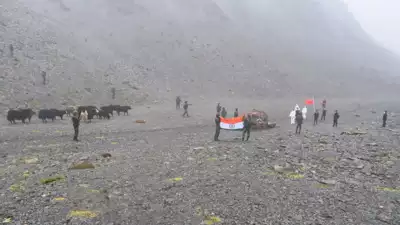India and China have reached an agreement to revert to the patrolling arrangements along the Line of Actual Control (LAC) in eastern Ladakh, which were in place prior to the 2020 Galwan clashes. The deal specifically covers the contentious areas of Depsang and Demchok. This development follows extended negotiations aimed at reducing border tensions that have persisted since the 2020 standoff.
External Affairs Minister S. Jaishankar recently noted that approximately 75% of the “disengagement problems” with China had been resolved, with ongoing efforts to address the remaining concerns. He remarked that India and China had returned to a situation comparable to the pre-2020 LAC conditions, with progress made in allowing mutual patrolling access to blocked areas.
Despite the progress, there was no mention of withdrawing the tens of thousands of additional troops deployed by both nations along the Ladakh border since 2020. China has yet to issue an official statement on the agreement.
Strategic Importance of Disputed Areas
Demchok: Situated near the southern end of the LAC in Ladakh, close to the Himachal Pradesh border, Demchok has historically been a flashpoint. It was the site of Chinese incursions during the 1962 Sino-Indian conflict. China has, in the past, blocked Indian infrastructure projects here.
Depsang Plains: A strategically vital flat terrain located near Daulat Beg Oldie (DBO), Depsang is part of the disputed Aksai Chin region. The area provides easy mobility for troops and military vehicles, making it crucial for India, which has built a road to the region. China’s control of parts of this area complicates India’s ability to maintain access to DBO.
Galwan Valley: Known for the deadly clashes in 2020, Galwan Valley holds significant strategic importance for both nations. For India, the Darbuk-Shyok-DBO (DSDBO) road, a key supply route, runs near this area, while China seeks control of vantage points overlooking this critical infrastructure.
Background and Tensions Since 2020 Clashes
The Ladakh region has been on high alert since the 2020 clashes, which began on May 5 at Pangong Tso lake and escalated into the fatal Galwan Valley encounter on June 15. In the aftermath, both sides bolstered their military presence along the LAC, with China reportedly constructing bunkers, trenches, and other fortifications, including a pier at Pangong Tso lake.
Despite the partial disengagement from areas such as Pangong Tso’s northern and southern banks, Gogra, and Galwan Valley, tensions have remained high due to the ongoing troop build-up and military infrastructure in these contested areas.
A Long-Standing Border Dispute
The LAC, established after the 1962 Sino-Indian war, remains an undefined and disputed boundary, spanning from Arunachal Pradesh in the east to Ladakh in the north. While India considers the LAC to be 3,488 km long, China claims it is significantly shorter. Beijing also claims 90,000 sq km of territory in northeastern India, including parts of Arunachal Pradesh, while India insists that 38,000 sq km in China-controlled Aksai Chin should belong to Ladakh.
The current agreement marks a crucial step in de-escalating tensions, but the path to lasting peace along the LAC remains uncertain, with multiple unresolved issues still in play.




